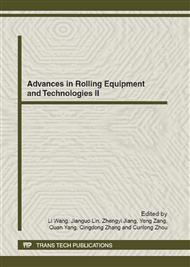p.359
p.364
p.371
p.376
p.382
p.390
p.400
p.404
p.410
Research and Application of Dynamic Secondary Cooling Control System for a Continuous Steel Billet Caster
Abstract:
A two-dimensional heat-transfer model for transient simulation of a billets caster is presented. Its accuracy is verified through measured billet temperature and shell thickness. Billets temperature and solidification are computed by this model as a function of time varying casting speed, secondary cooling water flow rates and temperature, billet cross section, steel grade, and pouring and ambient temperatures. A control methodology and algorithm suitable for online control of 5 strands billet continuous casting machine is integrated in this model. The ability of this model to control the surface temperature profile is demonstrated through dynamic and precise adjustment of secondary cooling water flow rates. This secondary cooling system has been applied to a billet caster in Hangzhou Steel Corporation.
Info:
Periodical:
Pages:
404-409
Citation:
Online since:
October 2012
Authors:
Keywords:
Price:
Сopyright:
© 2012 Trans Tech Publications Ltd. All Rights Reserved
Share:
Citation:


